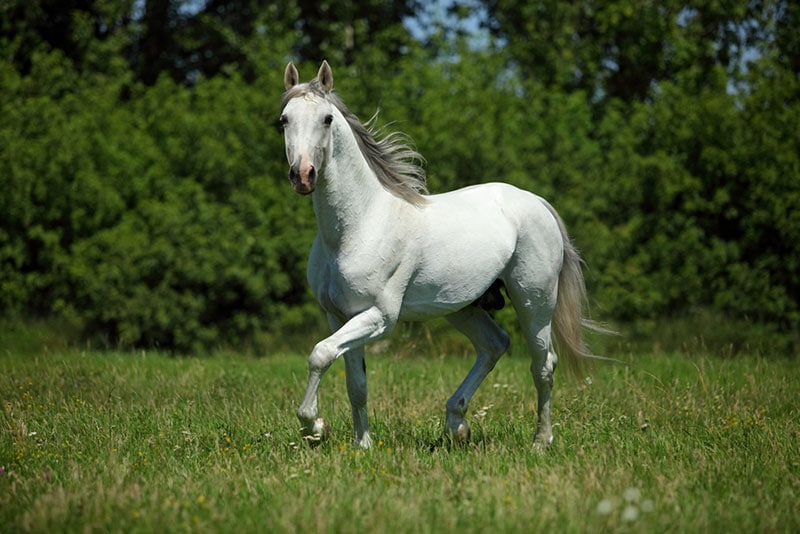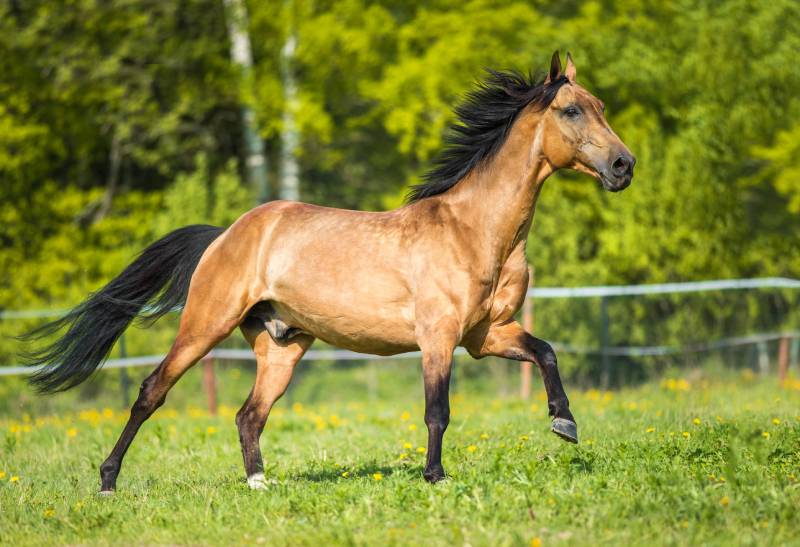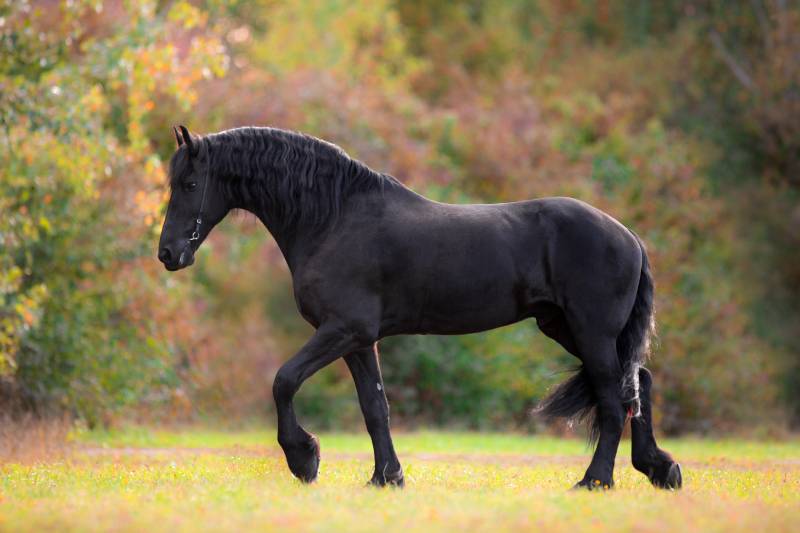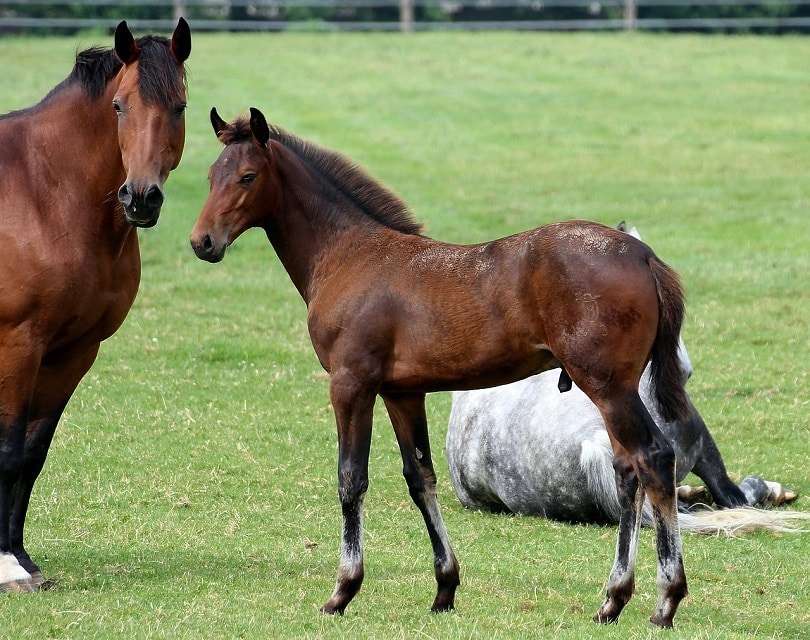
Click to Skip Ahead
Horses have a long history with humans, but today’s horses differ slightly from their ancestors. When you think of a medieval war horse, you might imagine a large, imposing animal charging into battle, like Hollywood generally depicts in their movies. But researchers have found that medieval horses were “surprisingly small“.
Instead of being bred for just their size, the horses were bred for success in specific functions, their temperament, and the right physical characteristics required for warfare. So, let’s take a closer look at some of these horses and their roles with their humans.

Background & History
Collectively, medieval horses are known as chargers, and within this category, they are separated into destriers and coursers. Destriers tended to be tall and strong, and they had to carry armored men and their own armor with ease. In contrast, coursers were lighter, shorter, swifter, and unarmored.
Horse breeds during this time weren’t as distinctive as they are now, and we rely heavily on historians’ best guesses. The most common medieval horses were Andalusians, Arabians, Friesians, and Percherons.
The breeds we know and love today aren’t the horses that would have ridden into battle during medieval times; hundreds of years of breeding and the fact we now don’t use them in war have made modern horses different from their ancestors. However, it’s safe to assume that many modern breeds can be traced back to destriers and coursers, and by looking at them, we can get an idea of how they were once used.
The 8 Medieval War Horse Breeds
1. Arabian

The Arabian’s ancestors can be traced back to Ancient Egypt, Greece, and the Ottoman Empire. They’re light and small and probably not a horse you expected to be on the list. However, while petite, they’re agile and have dense bones that allow them to carry extremely heavy loads. This made them popular in light cavalry charges as the heavier war horse was used less often.
During the Middle Ages, they were picked for their agility, strength, and fiery personality. And while they have changed slightly, they are still incredibly popular, thanks to their endurance and intelligence.
2. Andalusian

The Andalusian is a strong, powerful, yet graceful horse. They are direct descendants of the Iberian horses from Portugal and Spain and have breeding records and a prized nobility that dates back to the 13th century. They were popular as cavalry horses because of their intelligence and ability to carry heavy weights. Henry VIII, the King of England from 1509 until 1547, loved the Andalusians and used them in his cavalry.
This breed is known for their intelligence, good-natured attitude, and agility, and they do very well in various events and sports. While they come in many colors, 80% of Andalusians in the United States have gray coats. They also star in fantasy and historical films such as The Lord of the Rings and Gladiator.
3. Akhal Teke

The Akhal Teke is considered one of the world’s oldest breeds and is the only remaining link to the Turkoman horse, which originated in central Asia between 3000 and 4000 BCE. They’re known for their endurance, spirit, and speed and were referred to as “Golden Horses” because of their distinctive metallic coat.
Today, the Akhal Teke is rare, making them pretty pricey since there are only around 5,000 in the entire world. They’re compliant and sensitive, and it’s thought this was bred into them on purpose so they would cooperate with their humans. Their temperaments and loyalty have been likened to dogs’ devotion to their owners.
4. Barb

The Barb originated in North Africa and is a significant part of African culture; cave paintings of the Barb are thousands of years old. These horses were used in warfare and for work and hunting. They are very similar to Arabian horses and were used for their endurance and speed, just like the Arabians.
Later, in 16th century Europe, they were trained for dressage because of their eagerness to learn and gentle natures. Their numbers are dwindling, but a Spanish Barb is still bred in parts of the United States.
5. Friesian

The Friesian looks like it’s wandered out from the pages of a fairytale. They’re known for their beautiful black coat, luxurious, long tail, and mane. They’re heavy and probably close to what you think when envisioning a typical medieval war horse.
Many horses during medieval times were large and strong enough to carry armored knights but were too docile and slow to be very effective during war. However, horses that were agile and fast were too skittish and light to meet the needs of a heavy soldier. However, the Friesian was the perfect warhorse; they were agile, strong, fast, and courageous.
Friesians are used extensively in filmmaking and look spectacular in battle reenactments and historical dramas. Unfortunately, they are prone to some genetic disorders such as megaesophagus, dwarfism, aortic rupture, and hydrocephalus, which are believed to be caused by inbreeding and might contribute to their short average lifespan. However, some Friesians have been known to live until they are 30.
6. Holsteiner

The Holsteiner is athletically built and is known for being powerful, with heavy high-set necks. They were in demand later in the Middle Ages as cavalry horses. The Petersen monks bred the Holsteiner to be strong enough to carry heavy soldiers into battle but also to be agile and possess great endurance. This led the Holsteiner to be an incredibly effective warhorse.
They are known now for having agreeable personalities and being resilient and responsive. They use these traits to compete and do well in dressage and show jumping.
7. Marwari

The Marwari traditionally stood between 13.3 and 14.3 hands, but now they tend to be just over 15. They were primarily used as light cavalry horses during the Early Middle Ages and are recognized for their grace and bravery. The Marwari is rare now, but they once were in the tens of thousands and were particularly popular in the 16th century.
In the 20th century, economic and political disorder caused the Marwari to come very close to extinction. However, in 1995, the Marwari received another boost. Now, they are the national horse of India, and in 2014, they were the first Asian horse to have their genome mapped. This revealed Mongolian and Arabian components involved in the breed’s genetic makeup.
8. Mongolian Horse

The Mongolian Horse is one of the few ancient horse breeds on our list that exists today relatively unchanged. Their genetics stretches back an impressive 240,000 years, and the Mongols used them for thousands of years. They’re powerful and stocky but slower than some of the other horses on our list.
The Mongolian Horse is still incredibly popular and has one of the largest populations, with over 3 million horses worldwide. Mongolia has one of the strongest and oldest horse cultures and has learned to utilize every part of the animal efficiently and respectfully. Many horses are still used for transportation while their milk is consumed and made into an alcoholic beverage. Their hide and skin are used for clothing and shelter, and their meat and blood are used for food.
9. Percheron

The Percheron has the classic, impressive look of a medieval destrier. They were used as warhorses in the High and Late Middle Ages and were picked because their size and strength made them ideal for the French heavy cavalry.
After the decline of knights, the Percheron’s role shifted, and it was used in forestry and agricultural work and pulled coaches. Along with this change, they were bred to be taller, stronger, and more docile. Now, they are mainly used as draft horses and can be black or grey.
10. Shire

Shire horses were likely not around in the Middle Ages. However, it’s thought their ancestor, the British Great Horse, was used in battle. After their war career and before machinery was invented, Shires were used for their immense pulling power.
They arrived in the United States in 1853 but never became popular as workhorses. Instead, they were used for breeding to increase the sizes of small farm horses. Now that draft horses are no longer needed, the Shire is endangered in the United States, UK, and Canada.

Conclusion
As the roles of horses have changed through the years, so have their characteristics and traits. All except the Mongolian horses have evolved into very different horses from their ancestors. However, it’s possible to see remnants of the traits once needed on the battlefield. Whether they were used for their strength and power or their agility and speed, it’s clear that these horses have played an essential role in shaping our history.
Featured Image Credit: Annabell Gsoedl, Shutterstock







